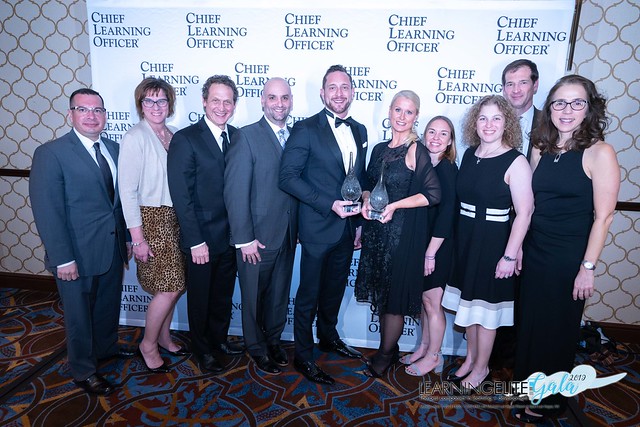
Continuous learning and a revamped measurement philosophy are helping KPMG develop a future-ready workforce.
by Andie Burjek
June 18, 2019
A regular on the LearningElite list since 2013, this year KPMG cracked the Top 5.

A key aspect of KPMG’s learning strategy has always been to continually raise the bar, said Corey Muñoz, chief learning officer of KPMG. The professional services organization needs its talent to be on top of their game. Amid constant changes, constant improvements are necessary — both for professional services consultants and the organization itself.
Learning plays a key role in that continuous improvement, and KPMG’s L&D strategy is going in a direction unique to organizations in this increasingly digital world. The organization is building a learning, development and innovation center called the KPMG Lakehouse in Lake Nona, Florida, a campus that will open in January 2020, Muñoz said.
Most organizations are headed in the digital direction, but learning must be more multifaceted, according to Muñoz. “Not everything is a video you can watch. You can know something, but to actually do it, that takes time and that takes feedback and actual space where you can practice and learn,” he said.
Employee feedback was an important source of inspiration for this new center, Muñoz said. KPMG conducted interviews and focus groups to pick employees’ brains and help figure out how to create the experience of being at the KPMG Lakehouse. This translated into what Muñoz calls the three layers: experience, environment and ecosystem.
Experience refers to how the center facilitates the learners’ discovery of key takeaways in the classroom. Environment refers to how the center itself is designed to promote positive learning behaviors like reflecting on what you’ve learned and networking with colleagues. For example, the center has outdoor spaces designed to help facilitate group work, and it has exercise facilities and walking paths to encourage employees to take a break and work out their body as well as their mind.
Finally, ecosystem means that everything a learner picks up at the center should impact them during the 51 weeks of the year they’re not there, Muñoz said. Learning isn’t an isolated incident. How it impacts one’s everyday working life matters.
“What happens in the classroom doesn’t stay in the classroom,” Muñoz said.
As mass amounts of data become available for teams in basically any business unit, the L&D function of any organization relies on data to support its business impact. The way KPMG does this is unique. Rather than create a program and then analyze its impact on the bottom line, the organization “started with the bottom line,” Muñoz said.
“We start with the business problem and the business outcome that we’re striving for, and then we back into the learning, the curriculum and the courses, versus the opposite of what sometimes happens. You create a course and then think about, ‘What kind of outcomes could this impact?’ ” Muñoz said. “We’ve flipped that measurement perspective on its head so that we could really get very specific with what we’re measuring, how we’re measuring it and how we tell our story.”
For example, tax staff training needed to be revised while the Tax Cuts and Jobs Act of 2017 was evolving. This required the learning function to be agile and make real-time adjustments to courses and on-demand learning resources to prepare tax professionals for the changes in tax law.
Agile learning is especially important to KPMG, as one of its key metrics is retention. Retaining top talent is so vital to a professional services organization whose “product” is the knowledge, skill and experience of professionals, Muñoz said.
KPMG has also created an internal department of measurement experts, the Performance Measurement Group. Members of this department have advanced degrees in areas like industrial psychology, instructional design and business.
Learning is more than what someone consumes at the moment, Muñoz said. It’s also the impact of something less structured, like informal learning. That’s why having a team of measurement specialists and experts in valuable.
The soon-to-be-open KPMG Lakehouse is a major part of the company’s future of learning, but there’s a lot more to be excited about, Muñoz said. For example, partners and senior leaders in the firm sometimes teach in L&D programs. Now, they can go through an accreditation process to help build their skill set and pass on what they know to learning professionals at the center.
Muñoz is also excited about moving forward with intelligent automation. There are many manual processes that could be automated, but one of the implications of the “start with the bottom line” measurement philosophy is smart tech investing. Rather than finding a trendy tech solution, investing in it and then finding a problem for it to solve, KPMG does the opposite.
“One of the things I’m very passionate about is that I want our learning strategy to drive what technology investments we make versus technology driving what we do with learning,” Muñoz said. “It’s technology with a purpose.”
SNAPSHOT:
In 2018, KPMG launched the Experience Disruptors and Trends series. These innovative, technology-enabled simulations challenge teams of participants to perform in the role of their clients and navigate a shifting business landscape. Ninety percent of participants agreed the program helped enable richer client conversations.
Company size: 40,974
Location: United States




